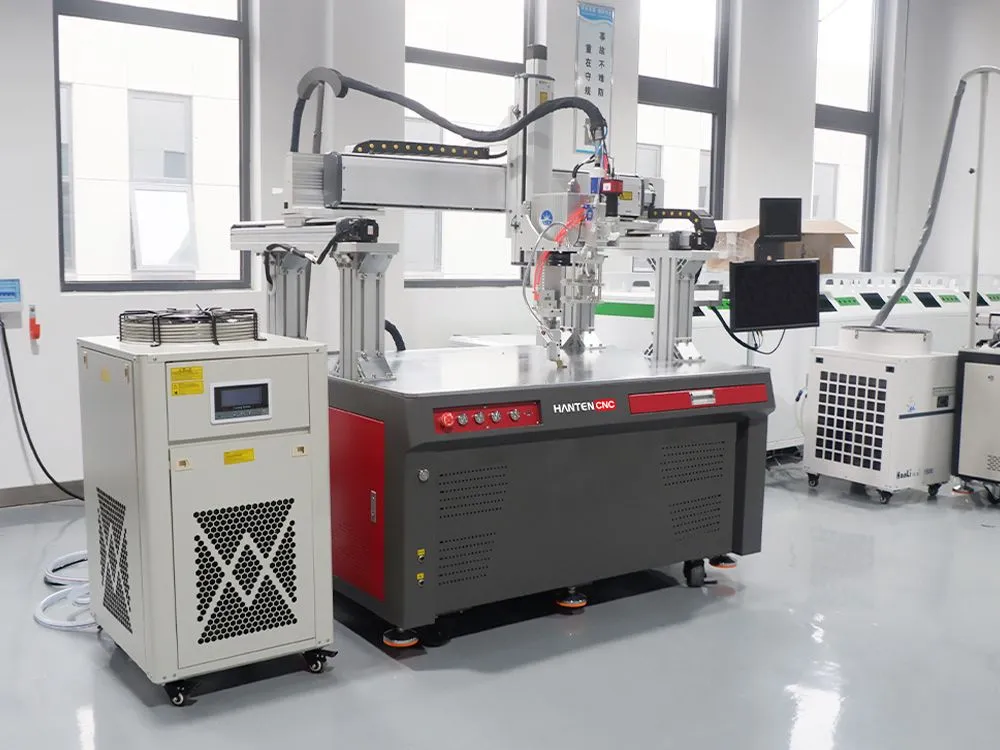As a highly precise welding process, laser welding is widely used in lithium batteries, particularly in battery cell assembly, where laser welding battery cells technology plays a crucial role in laser welding batterys cell assembly.
This article will first explore the basic principles of laser welding. Next, we will introduce the advantages of laser welding in lithium battery production. Then, we will delve into the specific application areas of laser welding in lithium battery manufacturing. Finally, we will focus on how to use laser welding to assemble battery cells, which we call laser welding battery cells.
This article uses vivid examples and practical experiences from HANTENCNC to showcase the innovative applications of laser welding in lithium battery production. Before we know how is laser welding battery cells in lithium battery production, lets’ learn about the working principle of laser welding battery cells.
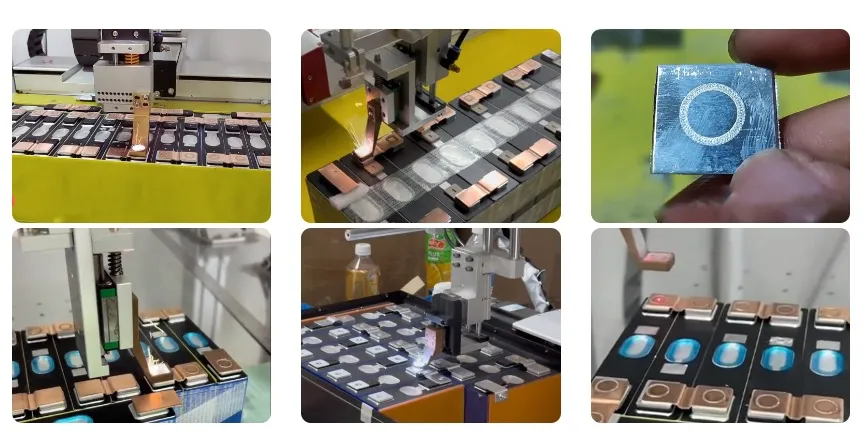
1. Working Principle of Laser Welding Battery Cells
Laser welding is a highly precise welding technique that utilizes a laser beam to heat the material to a molten or semi-molten state. By controlling the position and intensity of the laser beam, the materials can precisely join together. Laser welding is typically used in welding tasks that require high precision and complex structures, such as in the field of lithium batteries.
During the laser welding process, the laser beam is focused on a small area of the workpiece surface, raising the temperature to the point where the material melts or reaches a semi-molten state. Moving the laser beam can fuse the welding materials together. Laser welding concentrates energy highly, enabling high-temperature, high-speed, and deep welding while minimizing the heat impact on the surrounding materials.
Laser welding is widely used in the manufacturing of lithium battery applications such as laser welding battery cells etc. For instance, in the electrode manufacturing process of lithium batteries, laser welding is used to connect electrode sheets and electrode wires, ensuring the internal conductivity of the battery. During the battery sealing process, laser welding is employed to weld sealing materials, providing the integrity of the battery casing and preventing leakage of the internal liquid electrolyte.
Through its highly precise characteristics, laser welding technology provides an efficient, stable, and reliable welding solution for lithium battery manufacturing, driving the development and application of lithium battery technology.
2. Advantages of Laser Welding in Lithium Battery Production
Laser welding technology in lithium battery production has many advantages, such as high accuracy, welding stability, non-destructiveness to surrounding materials, scalability for mass production, and high controllability. The advantages are as follows:
2.1 Ensuring High Accuracy and Stability of Welding Points
Laser welding provides a highly precise welding process to control the welding position and depth. This precision is crucial for small and densely packed battery components, ensuring the stability and reliability of welding points.
Laser welding enables the rapid fusion of two materials, which can be identical or different, such as welding aluminum and copper. The high precision and efficiency of laser welding technology ensure the stability and reliability of battery cell components, offering an efficient, stable, and reliable welding solution for lithium battery manufacturing. This, in turn, promotes the development and application of lithium battery technology.
2.2 Ensuring Integrity of Welding Locations and Structural Integrity
Laser welding is a non-contact welding method, involving no physical contact during the welding process. The heat generated by laser welding is relatively low, reducing the thermal impact on surrounding materials. This is crucial for sensitive components and materials within lithium battery assemblies, avoiding potential issues related to contamination and damage that might occur in traditional welding methods. This aspect is particularly important for delicate battery materials and components.
2.3 Suitable for Mass Production
Laser welding is a rapid and highly efficient welding method. It is characterized by high efficiency and speed, allowing the welding process to be completed in an extremely short time.
The high efficiency of laser welding is advantageous for the high production demands of mass manufacturing. It enhances production efficiency and reduces production costs significantly.
2.4 High Controllability
Laser welding offers high controllability, as welding parameters can be adjusted according to different materials and requirements during the laser welding process. This flexibility allows meeting the specifications and designs of various battery packs.
In summary, the application of laser welding battery cells or other components provides manufacturers with high-quality, efficient, and reliable welding solutions.
3. Applications of Laser Welding in Lithium Battery Production
In the manufacturing of lithium batteries, laser welding technology is primarily applied in six areas: electrode manufacturing, battery encapsulation, battery module assembly, sealing welding of cylindrical batteries, sealing pin welding, and battery management systems.
Lithium batteries constitute vast and intricate systems, comprising various components and layers. Each part may use laser welding technology. The battery cell, the core component of a lithium battery, consists of positive and negative electrodes, electrolytes, and separators. These components are stacked together, forming an electrochemical reaction unit, which serves as the fundamental operational unit of a lithium battery.
In the realm of lithium battery applications, the crucial production steps of “electrode manufacturing” and “battery module assembly” involving the laser welding battery cells. This article focuses on detailing the laser welding battery cells.
So, how is laser welding battery cells in lithium battery production? The following provides an overview of the assembly of battery cells using laser welding in lithium battery manufacturing:
4. Guide to Laser Welding Battery Cells
In the assembly process of lithium battery cells, laser welding plays a vital role and is utilized for four crucial components: sealing the battery case, connecting the top cover and case, welding the explosion-proof valve, and attaching the tab.
Let’s explore how laser welding battery cells:
4.1 Sealing the Lithium Battery Case with Laser Welding
The purpose of employing laser welding in sealing the lithium battery casing is to ensure the integrity and tightness of the battery shell, preventing electrolyte leakage.
Sealing the lithium battery casing with laser welding is mainly applied to early small-sized lithium batteries with a wall thickness of approximately 0.3mm. It requires sealing welding on all sides, and stainless steel is the primary material.
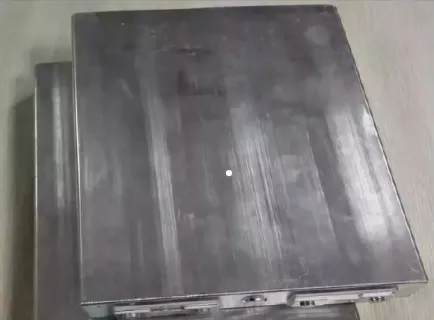
When welding such products, it is necessary to use the battery laser welding machine produced by HANTENCNC.
Demonstration Video of HANTENCNC’s battery laser welder
HANTENCNC’s newly launched gantry-type Galvo laser welder, which is particularly ideal for precise laser welding battery cells and other components.
A battery laser welding machine, typically ranging from 1000 to 6000 watts, is used for this process. A recommended specification for casing sealing is a 1500-watt laser power with an output frequency of 3000Hz.
Inert gases such as argon and nitrogen are utilized during welding to achieve a complete seal on the casing. After welding, the assembled case undergoes a gas filling and discharge test in a water tank.
The welding machine utilizes WSX’s industrial dual swing welding head, allowing a weld seam width of up to 5mm with an effective width of 3mm. Combined with a high-resolution CCD camera, real-time monitoring of the welding position and quality is ensured.
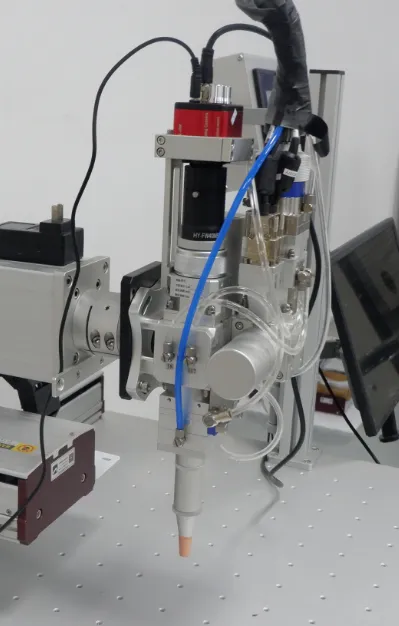
HANTENCNC’s newly launched gantry-type Galvo laser welder uses WSX’s industrial dual-axis welding head, capable of achieving a weld seam width of 5mm with an effective width of 3mm. Coupled with a high-definition CCD, it enables real-time monitoring of welding position and welding quality in laser welding applications for lithium batteries.
4.2 Laser Welding for Sealing Lithium Battery Lid and Casing
Using laser welding to connect lithium batteries’ lid and casing is important to ensure the battery structure is strong and the inner components stay stable.
For lithium batteries with aluminum casing, the casing is shaped by pressing, and the lid is precisely made using CNC machines. After filling the casing with battery materials, the lid and casing must be sealed by laser welding.
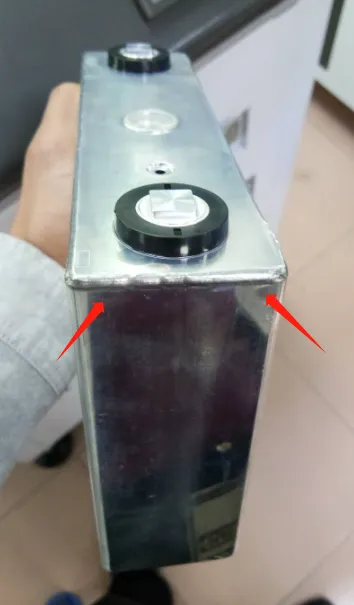
Welding Spot for the Lid
To seal the lid and casing, it is necessary to use a battery laser welding machine. The lid welding involves welding all four sides to ensure complete sealing. This means the casing might break even under a gas pressure of 4 kg, but the welded part should stay intact, showing the welding was successful.
Typically, we use the HANTEN CNC 1500-watt battery laser welding machine. We can also design special fixtures for production, making it convenient for our customers.
4.3 Laser Welding for Lithium Battery Safety Valve
Laser welding is used for attaching the safety valve to lithium batteries. This ensures that the battery can safely release internal pressure in emergencies, making the battery safer.
Lithium batteries contain a lot of energy and can explode if punctured or squeezed. So, a safety valve is welded onto the battery’s top cover. This valve helps release pressure safely, preventing the battery casing from breaking and causing bigger dangers.
The safety valve is usually placed on the battery’s top cover. It’s made from thinner material and is welded to the casing, as shown in the picture.

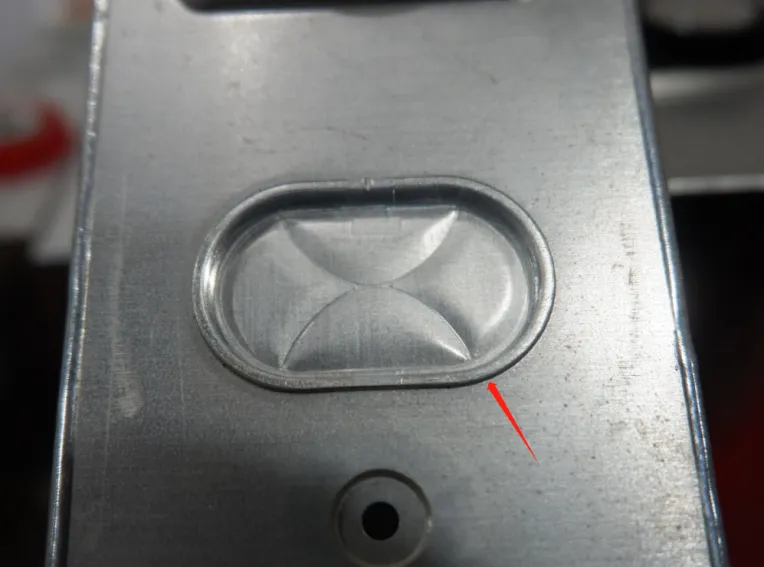
For welding these parts, both platform welding and galvanometer laser welding can be used. We suggest using a 1500-watt platform battery laser welding machine with side blowing to control heat and improve the appearance of the weld.
4.4 Laser Welding for Battery Tab Welding in Lithium Battery Production
4.4 Laser Welding for Battery Tab Welding in Lithium Battery Production
Laser welding for battery tab welding in the lithium battery production process ensures stable energy conductivity.
Tab welding is common in soft-pack lithium batteries. The tabs, connected to the battery’s positive and negative electrodes, are conductive materials like metal, such as copper, brass, or aluminum. Welding requirements include no overlap of materials and precise control of laser energy.
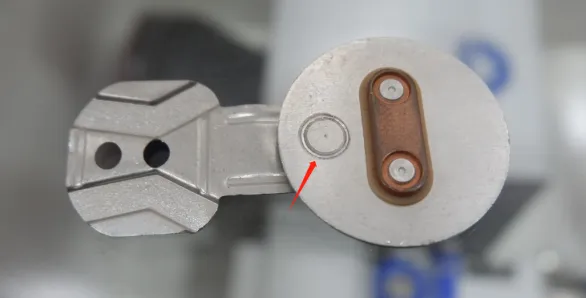
Laser Welding
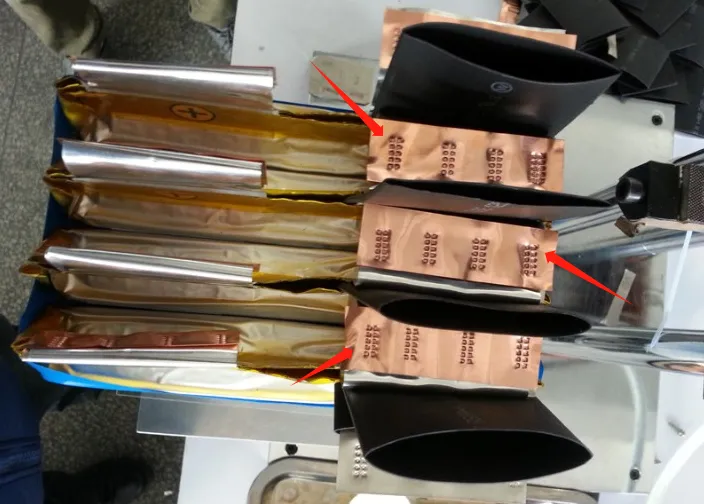
VS Traditional Ultrasonic Welding
When welding tabs, we recommend using a laser galvanometer welding machine with a maximum swing speed of 4000mm/s, combined with a 2000-3000 watt laser. This setup can weld aluminum or copper tabs ranging from 1-2.5mm.
Compared to traditional ultrasonic welding, the key advantage of laser galvanometer welding machines is that they require no consumables and produce minimal or no waste gases or smoke, ensuring high processing efficiency.

HANTENCNC offer platform welding machines and galvanometer welding machines with various stroke lengths. if you interest at laser welding battery cells or our battery laser welding machines, feel free to contact us.
Conclusion
Lithium batteries are a large and complex system. We’ve covered laser welding battery cells. Still, there are many other laser welding applications we haven’t discussed, such as sealing welding for cylindrical batteries, welding of sealing pins, and more.
As lithium battery technology advances, I believe there will be even more laser welding applications. Laser welding, an environmentally friendly method, will become more widely accepted.

